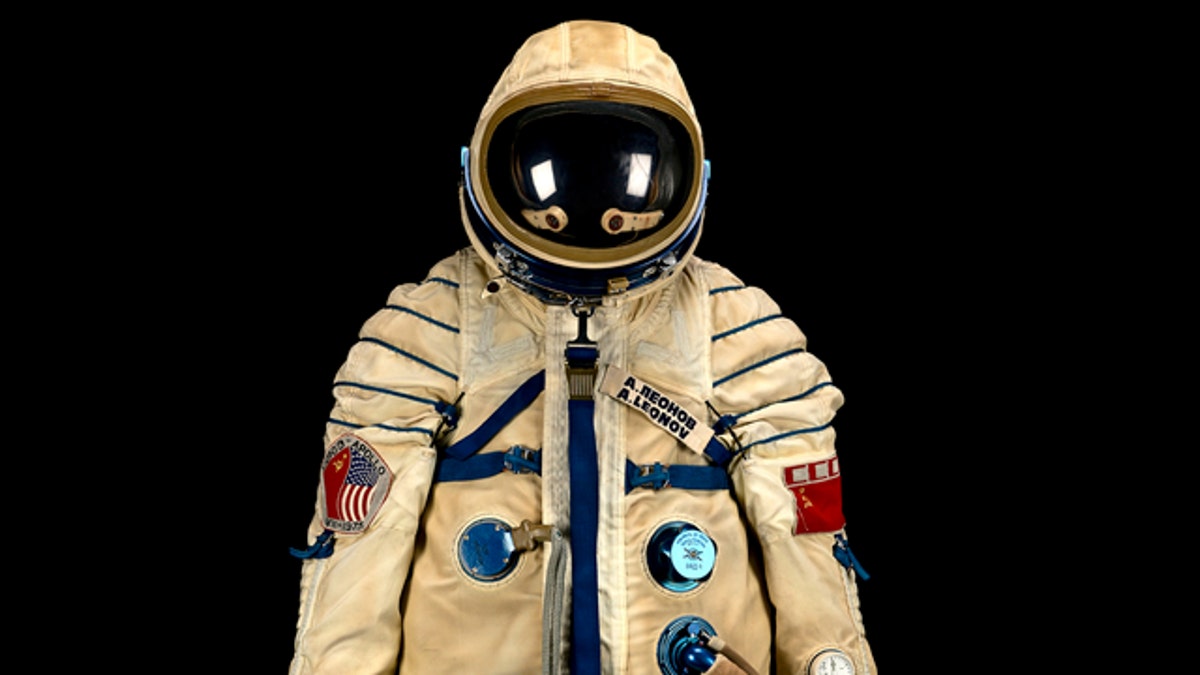
This spacesuit was worn by Russian cosmonaut Alexei Leonov during the historic Apollo-Soyuz Test Project, a joint space mission between the U.S. and Soviet Union in 1975. (Bonhams)
There's still a couple of days left to find that perfect geeky but interesting Hallowe'en costume. Stumped for ideas? How about going as a phantom cosmonaut.
The Soviet Union's early space program was shrouded in mystery. Missions weren't announced until they were successfully off the ground, and even then details were sparse and often misleading. Like the report falsely saying Yuri Gagarin landed in his Vostok spacecraft when he actually parachuted out and landed separately.
SLIDE SHOW: True Halloween Horror Stories from Space
Along with the misleading information was a series of misinterpretations by observers culminating in a list of cosmonauts that, in the 1960s, were possibly real and had possibly died on covered up missions.
So one question on everyone's mind at the end of April 1961 was whether other cosmonauts flew and died before Yuri Gagarin went into orbit.
Early Soviet spaceflight rumors started trickling over to the West in early 1958, well before NASA was established. The word from Moscow cryptically mentioned a manned flight suborbital flight reaching a peak altitude of 186 miles. Though it turned out not to be a real flight but a fictional radio program, Westerners were taken in by the story.
Austrian Rocket pioneer Hermann Oberth gave some credence to the story later that year, referring to a pilot killed on a suborbital flight but didn’t add any substantial information. Nevertheless, the seed of a secret Soviet flight had been planted.
The stories really took off in 1959 as Americans looked for evidence of the Soviet equivalent of NASA and its Mercury astronauts. There was little question that the Soviets had a space program, but details came through questionable and unofficial channels -- hearsay at industry events and in casual conversations at cocktail parties.
ANALYSIS: Gagarin's Falsified Flight Record
A sketchy picture emerged of a Soviet space program with three World War II veterans named Belokonev, Kachur, and Grachev training as cosmonauts; a fourth cosmonaut, unnamed, was rumored to have been killed in a training accident.
That lost cosmonaut trainee reappeared in the following months. A two-page article titled "Flights to High Altitudes" in the Russian weekly photo magazine Ogonyok showed images of doctors, technicians, and subjects testing life support equipment. That there were three men -- in fact the real Belokonev, Kachur, and Grachev -- and not four seemed to solidify the existence of a lost fourth man. That they weren't cosmonauts didn't matter. Western reporters treated them as the real thing and assumed the pictures showed their actual training facilities.
As more reports came from Moscow about high altitude flights and life support systems, the new men in pictures were assumed to be unknown cosmonauts. So to Westerners is wasn't a question of whether or not there were cosmonauts but how many were in training.
Rumors got a boost in 1961. On Feb. 4, the Soviets announced the imminent launch of a seven ton Sputnik, the largest satellite ever launched at the time. Western specialists listened to the launch on radio to hear moans, a human heartbeat, and Russian morse code. It sounded like the man was dying, and right at the moment when staging should have occurred the heartbeats stopped and the transmission ended. It was assumed that the cosmonaut on board met a fiery end that day, perhaps Belokonev, Kachur, or Grachev.
But it didn't entirely add up. The launch was broadcast on a radio frequency easily accessible to even amateur operators. It would be equally easy to broadcast a fake manned launch on a same frequency, or add a human sound to an unmanned launch.
ANALYSIS: The Psychology of Sputnik
More phantom launches emerged early that year. On April 9, just one day before Gagarin was scheduled to fly, reports came that the Soviets had already put a man into orbit. According to the British Communist Newspaper The Daily Worker, Lieutenant Colonel Vladimir Sergeyevich Ilyushin was launched into orbit on April 7 or 8 and circled the earth three times in his spaceship Rossiya (Russia) before landing safely.
But the flight wasn't perfect. There was some technical mishap with the spacecraft, and he came back from his flight deranged. Unfit to show to the world, he was hidden and his accomplishment swept under the rug.
But this was nothing more than a fantastic story. Ilyushin was a pilot but he never joined the Soviet space program.
Even within the Soviet Union the secrecy of the space program created rumors of phantom cosmonauts. Dr. Vladimir Golyakhovsky met a mystery patient in March of 1961, a severely burned man was rushed the his hospital under the name Sergeyev Ivanov. The doctor had no information about who the man was or what had happened, but knew from the officials guarding his room that he was important.
The man wasn't Ivanov but Valentin Bondarenko. He actually was a cosmonaut and a victim of an oxygen fire in training. As if to fuel rumors, his death was quietly hushed up.
None of the stories of lost cosmonauts proved to be true, and the Soviet celebration after Gagarin’s flight let little doubt that he'd gone into orbit. Soviet news managers were partly responsible for spreading stories of lost cosmonauts with their evasive, boastful, and often distorted presentation that created the mysterious and secretive atmosphere.
But at the same time, Soviet space managers did little to quash these rumors, and in many cases not denying the missions’ existence was proof enough for Westerners that unknown men died in the Soviet pursuit of space.
It wasn't until decades later that the full picture of the Soviets' early space program came to light. While they did cover up failed unmanned launches, no cosmonauts were killed on sketchy rocket launches before Yuri Gagarin's orbital flight
